
The classical guitar is a member of the guitar family used in classical music. An acoustic wooden string instrument with strings made of gut or nylon, it is a precursor of the acoustic and electric guitars which use metal strings. Classical guitars are derived from the Spanish vihuela and gittern in the fifteenth and sixteenth century, which later evolved into the seventeenth and eighteenth century Baroque guitar and later the modern classical guitar in the mid nineteenth century.

The guitar is a fretted musical instrument that usually has six strings. It is typically played with both hands by strumming or plucking the strings with either a guitar pick or the finger(s)/fingernails of one hand, while simultaneously fretting with the fingers of the other hand. The sound of the vibrating strings is projected either acoustically, by means of the hollow chamber of the guitar, or through an electrical amplifier and a speaker.

The harp is a stringed musical instrument that has a number of individual strings running at an angle to its soundboard; the strings are plucked with the fingers. Harps have been known since antiquity in Asia, Africa and Europe, dating back at least as early as 3500 BC. The instrument had great popularity in Europe during the Middle Ages and Renaissance, where it evolved into a wide range of variants with new technologies, and was disseminated to Europe's colonies, finding particular popularity in Latin America. Although some ancient members of the harp family died out in the Near East and South Asia, descendants of early harps are still played in Myanmar and parts of Africa, and other defunct variants in Europe and Asia have been utilized by musicians in the modern era.

A lute is any plucked string instrument with a neck and a deep round back enclosing a hollow cavity, usually with a sound hole or opening in the body. More specifically, the term "lute" can refer to an instrument from the family of European lutes. The term also refers generally to any string instrument having the strings running in a plane parallel to the sound table. The strings are attached to pegs or posts at the end of the neck, which have some type of turning mechanism to enable the player to tighten the tension on the string or loosen the tension before playing, so that each string is tuned to a specific pitch. The lute is plucked or strummed with one hand while the other hand "frets" the strings on the neck's fingerboard. By pressing the strings on different places of the fingerboard, the player can shorten or lengthen the part of the string that is vibrating, thus producing higher or lower pitches (notes).

A mandolin is a stringed musical instrument in the lute family and is usually plucked with a plectrum or "pick". It commonly has four courses of doubled metal strings tuned in unison, although five and six course versions also exist. The courses are normally tuned in a succession of perfect fifths. It is the soprano member of a family that includes the mandola, octave mandolin, mandocello and mandobass.

The ukulele is a member of the guitar family of instruments. It generally employs four nylon or gut strings or four courses of strings. Some strings may be paired in courses, giving the instrument a total of six or eight strings.
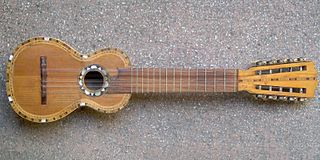
The charango is a small Andean stringed instrument of the lute family, which probably originated in the Quechua and Aymara populations in post-Colombian times, after European stringed instruments were introduced by the Spanish during colonialization. The instrument is widespread throughout the Andean regions of Ecuador, Bolivia, Peru, northern Chile and northwestern Argentina, where it is a popular musical instrument that exists in many variant forms.

The bouzouki is a musical instrument popular in Greece that was brought there in the 1900s by Greek immigrants from Turkey, and quickly became the central instrument to the rebetiko genre and its music branches. A mainstay of modern Greek music, the bouzouki has a flat front, usually heavily inlaid with mother-of-pearl. The instrument is played with a plectrum and has a sharp metallic sound, reminiscent of a mandolin but pitched lower. There are two main types of bouzouki: the trichordo (three-course) has three pairs of strings and the tetrachordo (four-course) has four pairs of strings.
The music of Trinidad and Tobago is best known for its calypso music, soca music and steelpan. Soca internationally noted performances in the 1950s from native artists such as Lord Kitchener and Mighty Sparrow. The art form was most popularised at that time by Harry Belafonte. Along with folk songs and African- and Indian-based classical forms, cross-cultural interactions have produced other indigenous forms of music including soca, rapso, parang, chutney, and other derivative and fusion styles. There are also local communities which practice and experiment with international classical and pop music, often fusing them with local steelpan instruments.

The mandola or tenor mandola is a fretted, stringed musical instrument. It is to the mandolin what the viola is to the violin: the four double courses of strings tuned in fifths to the same pitches as the viola, a fifth lower than a mandolin. The mandola, although now rarer, is the ancestor of the mandolin, the name of which means simply "little mandola".
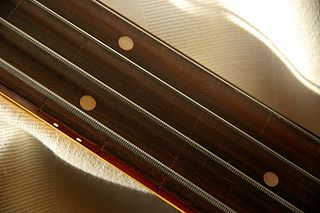
A string is the vibrating element that produces sound in string instruments such as the guitar, harp, piano, and members of the violin family. Strings are lengths of a flexible material that a musical instrument holds under tension so that they can vibrate freely, but controllably. Strings may be "plain", consisting only of a single material, like steel, nylon, or gut, or wound, having a "core" of one material and an overwinding of another. This is to make the string vibrate at the desired pitch, while maintaining a low profile and sufficient flexibility for playability.
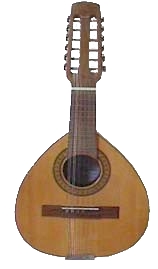
The bandurria is a plucked chordophone from Spain, similar to the mandolin, primarily used in Spanish folk music, but also found in former Spanish colonies.
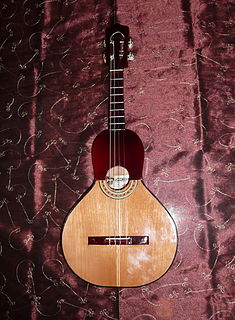
The bandola is one of many varieties of small pear-shape chordophones found in Venezuela and Colombia. They are related to the bandurria and mandolin.
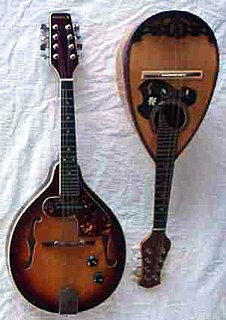
The electric mandolin is an instrument tuned and played as the mandolin and amplified in similar fashion to an electric guitar. As with electric guitars, electric mandolins take many forms:

The octave mandolin is a fretted string instrument with four pairs of strings tuned in fifths, G, D, A, E, an octave below a mandolin. It is larger than the mandola, but smaller than the mandocello and its construction is similar to other instruments in the mandolin family. Usually the courses are all unison pairs but the lower two may sometimes be strung as octave pairs with the higher-pitched octave string on top so that it is hit before the thicker lower-pitched string. Alternate tunings of G, D, A, D and A, D, A, D are often employed by Celtic musicians.

The mandore is a musical instrument, a small member of the lute family, teardrop shaped, with four to six courses of gut strings and pitched in the treble range. It was considered a new instrument in French music books from the 1580s, but is descended from and very similar to the gittern. It is considered ancestral to the modern mandolin. Other earlier instruments include the medieval European citole and the Greek and Byzantine pandura.
















